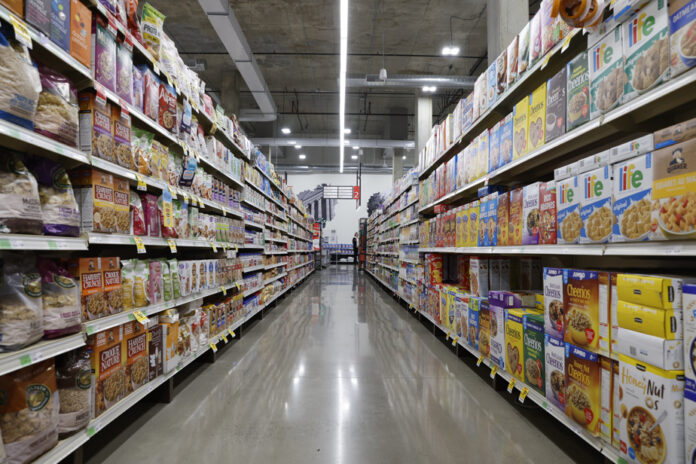A greater number of players in the food market industry would encourage lower prices for consumers, whose grocery bills continue to inflate, concludes a study published Tuesday by the Competition Bureau.
Currently, the industry is led by five major players in the country: Loblaw (Maxi, Provigo), Sobeys (IGA), Metro, Walmart and Costco.
Significantly, large food retailers’ gross margins “have generally increased modestly but significantly over the past five years,” according to the report, Canada Needs More Competition in the grocery sector, a title that speaks volumes about the findings of the Competition Bureau.
With margins up one or two percentage points since 2017, consumers have had to take between $1 and $2 more out of pocket for every $100 spent on groceries, reports example.
However, when appearing before a parliamentary committee in March, the leaders of the main major retailers hammered home that their profit margins had remained stable and that they had not taken advantage of inflation to inflate prices on the shelves.
According to figures released by Statistics Canada on Tuesday, grocery store prices rose 9% in May, from 9.1% in April.
And the conclusions of the organization are unequivocal. “When an industry is very competitive, companies usually cannot increase their margins. The fact that Canada’s largest grocers have generally been able to do this over the past five years, even modestly, shows that there is room for greater competition in the Canadian grocery sector. »
Two weeks ago, a report by the Standing Committee on Agriculture and Agri-Food recommended, among other things, that large grocery chains be taxed more if they were found to be making excessive profits.
The arrival in the country of international retailers like Walmart and Costco has greatly contributed to creating healthier competition. But more grocers from overseas are needed, the report also recommends.
“Canada needs solutions to control the price of the grocery cart. Increasing competition is a key part of the solution,” the document, which was compiled after interviews with a dozen industry representatives, also reads.
However, it has been impossible to understand to what extent the arrival of Costco and Walmart stores in the country has benefited consumers in constant search of low prices. “We have not quantified the benefits of this competition, admitted a senior official working within the organization, during a briefing with journalists. But it is clear that the entry into the country and the expansion of Costco and Walmart have been beneficial for prices. »
“Foster the growth” of independent merchants, implement a clear unit price display process to facilitate store-to-store comparisons, and “limit the use of ownership checks that make it difficult to open new ones grocery stores” are among the other key recommendations made to the federal government to foster healthy competition.
For its part, the Retail Council of Canada (RCDC), which represents the five main brands in the country, refuses to say whether the addition of new players in the landscape would allow consumers to pay a lower bill at the grocery store. . “The prices are already very low. So, inevitably, there is something that must work in the current system, ”says its president for Quebec, Michel Rochette.
Would prices be lower if there were more brands? “It’s tricky [as a question]. Canada and Quebec are quite open to competition. There is nothing stopping traders from coming here,” he replied.
Mr. Rochette also recalled that the report had “debunked” certain beliefs about the profits made by grocers. “The report did not conclude that the profits were excessive. It was noted that the margins were rather low, modest in fact. »
The Bureau’s decision to scrutinize rising food prices and analyze competition among major retailers was made in October. Nearly eight months later, the resulting report is nothing but a series of “pious wishes”, argues Jacques Nantel, professor and retail specialist at HEC Montreal.
“In many ways, these are findings that are very similar to a report [the Plumtre Report] that was tabled on the exact same issue in 1973, 50 years ago. He said much the same thing, especially about the importance of having more competition. »
He also raises the fact that the study recommends both the arrival of major foreign players and the multiplication of independent local merchants. Two ideas difficult to implement at the same time, according to him.
Was this long-awaited report too much noise for nothing? “Somebody had to do something. But we realize that there are not a lot of things that can be done [by the government]. »
Quebec is an example to follow, according to the report, with regard to the display of the unit price allowing consumers to compare prices for cartons of orange juice of different sizes, for example. This type of display is mandatory in the Belle Province, which is not the case elsewhere in the country.
Nearly 79% of Canadian consumers sometimes shop at several addresses in order to find the best prices, reveals the study by the Competition Bureau. And in their hunt for bargains, almost 61% of them are more likely to frequent a supermarket allowing them to accumulate points as part of a loyalty program.
The costs generated by the production of bilingual labels on packaged foods would deter some major international players from settling in the country. “However, some international grocers have told us that they are already used to doing this kind of labels in other countries and that they do not see this as a problem,” it also said.















